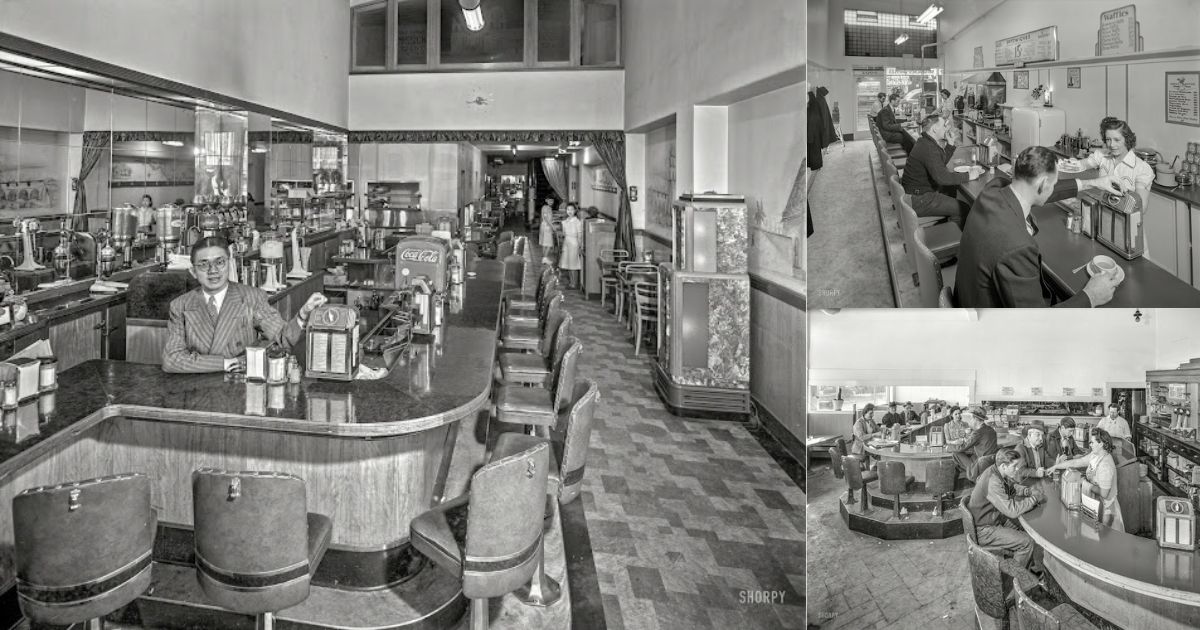The 1940s were a transformative era in American history, marked by the impact of World War II and the subsequent post-war period. As the war raged on from 1941 to 1945, the American economy experienced a significant shift. The creation of 17 million new jobs finally pulled the country out of the Great Depression, and millions of married women entered the labor force, contributing to the war effort.
One noticeable effect of these changes was a surge in the demand for restaurant meals. The number of meals served per day skyrocketed from a pre-war level of 20 million to over 60 million. However, the combination of increased patronage, labor shortages, government-ordered price freezes, and rationing of basic foods created a challenging environment for restaurants and cafeterias.
With gasoline rationing in place, many roadside cafes and hamburger stands were forced to close their doors. Rationing continued even after the war, causing wholesale prices to remain high. As women left their wartime jobs to return to their homes, patronage at restaurants declined. Furthermore, trained restaurant personnel were in short supply, adding to the industry’s struggles.
To adapt to these circumstances, restaurants turned to the food service methods and materials that had been developed for the armed services. The frozen food industry played a crucial role during this time, supplying restaurants with fish, French fries, and baked goods. The introduction of boil-in bags filled with pre-cooked entrees provided convenient options for both diners and establishments.
Interestingly, the military’s fast food assembly lines and serving techniques also found their way into commercial restaurants. This transfer of knowledge and practices brought efficiency and consistency to the industry. The influence of the armed services on American dining experiences during the 1940s cannot be underestimated.
To provide a visual representation of this era, here is a curated collection of 33 amazing vintage photographs. These images grant us a fascinating glimpse inside American restaurants and cafeterias from the 1940s. They capture the atmosphere, decor, and faces of a bygone era, reminding us of the remarkable journey that the American restaurant industry embarked on during one of the most defining decades of the nation’s history.
These images transport us back in time, offering a window into the past. They evoke nostalgia and curiosity, allowing us to imagine what it was like to dine in these establishments, surrounded by the unique sights and sounds of the 1940s. From elegant dining rooms to bustling lunch counters, from uniformed waitstaff to eager customers, these photographs capture the essence of a decade that shaped not just the restaurant industry but also American society as a whole.
As we reflect on these images, it’s clear that the 1940s marked a turning point for American restaurants and cafeterias. Despite the challenges imposed by war, shortages, and rationing, these establishments adapted, innovated, and persisted, leaving a lasting impact on the dining culture that followed.
In conclusion, the 1940s brought forth a taste of resilience, adaptation, and ingenuity in American restaurants and cafeterias. The demand for meals surged, the workforce evolved, and the industry met these challenges head-on. Through these vintage photographs, we can experience a slice of history and appreciate the resilience of those who navigated through one of the most transformative decades in American dining.
 |
| It’s 1942 and we’re back in San Francisco for another look at one of the many fine establishments made even finer by the installation of Buckley Music System’s “Music Box.” The eatery is Andy Wong’s “Fair Famous” Mission Trails Restaurant, Harvey Lum, manager, at 500 Sutter Street. |
 |
| San Francisco circa 1941. Restaurant counter. And another shot of the Buckley Music System “Music Box.” |
 |
| June 7, 1943. Restaurant soda fountain, Sausalito, California. |
 |
| August 1941. Chickens raised by FSA borrowers is good right down to the bone. Sunday dinner for flying cadets at Craig Field, Selma, Alabama. |
 |
| From San Francisco circa 1940 comes this uncaptioned photo of Joe DiMaggio and friend and at least a dozen cups of coffee. |
 |
| April 24, 1946. Pontiac zone managers’ banquet at St. Francis Hotel. |
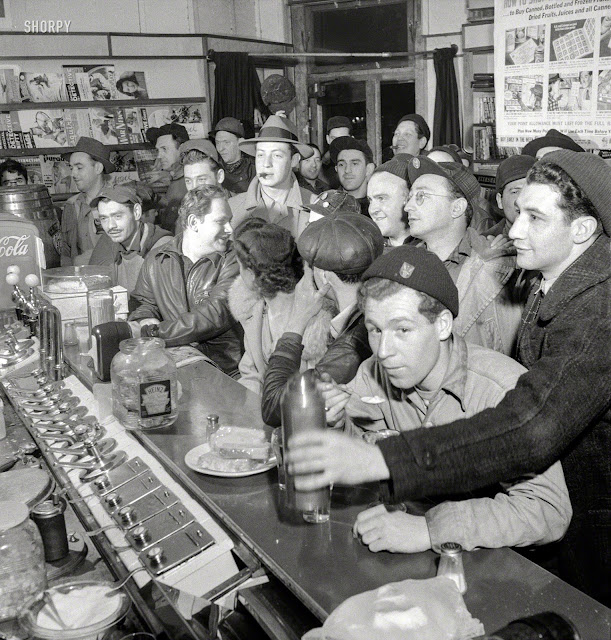 |
| April 1943. Baltimore, Maryland. Third-shift defense workers getting snack at drugstore on corner where their shared car will pick them up around midnight. |
 |
| September 1943. Columbus, Ohio. A Greyhound bus driver off duty. |
 |
| February 1943. Cafe society. Around Albuquerque, New Mexico. |
 |
| April 1943. Washington, D.C. Slightly inebriated couple at the Sea Grill. |
 |
| December 1941. Washington, D.C. Girls in Hot Shoppes restaurant. |
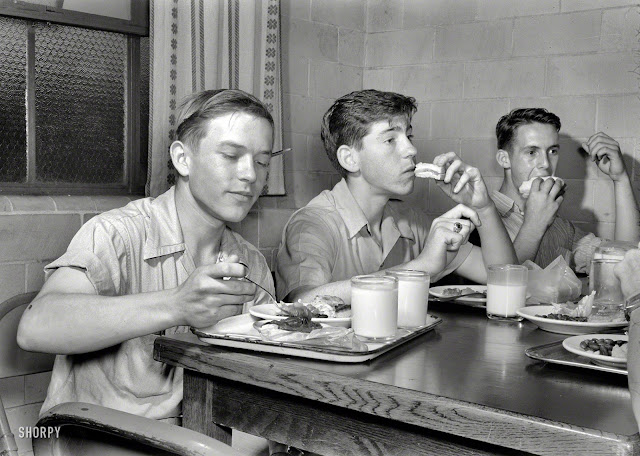 |
| June 1943. Keysville, Virginia. Randolph Henry High School. Cafeteria. Students don’t have much money so they bring produce from farms for which they receive tickets. Lunches cost about 15 cents. Typical lunch: candied yams, macaroni and cheese, fruit salad, deviled eggs, dessert and milk. Milk is free and children can have as much as they want. |
 |
| March 1943. Pearlington, Mississippi (vicinity). Truck drivers at a highway coffee stop on U.S. Highway 90. |
 |
| May 1942. A corporal in the Army takes his girl to dinner. Bakersfield, California. |
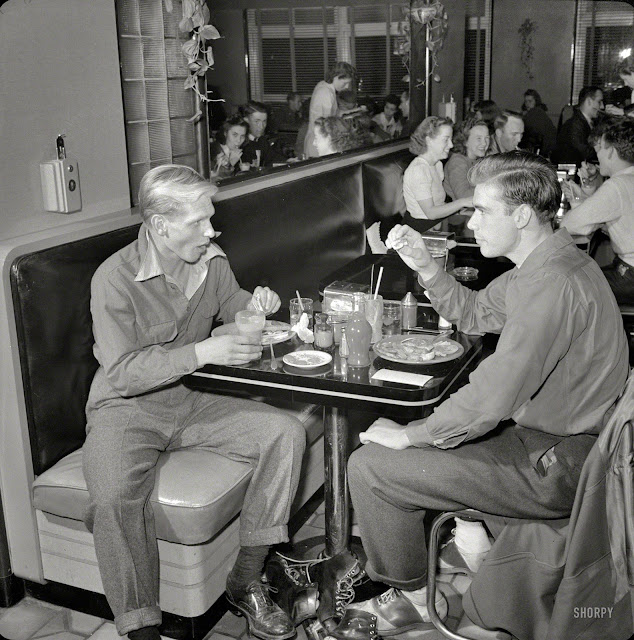 |
| December 1941. Washington, D.C. Diners in Washington Hot Shoppes restaurant. An exciting night of ice skating awaits, or has just concluded. |
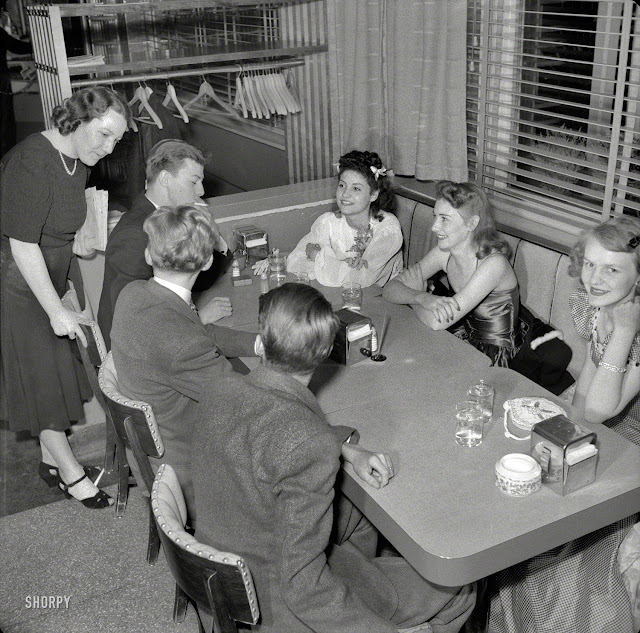 |
| December 1941. Hot Shoppe restaurant. Washington, D.C. |
 |
| December 1941. Washington, D.C. Washington Hot Shoppe restaurant. Tableware, clothes, shoes — discuss! |
 |
| December 1941. Washington, D.C. Hot Shoppe restaurant. |
 |
| June 1940. Washington, D.C. In the cafe at a truck drivers’ service station on U.S. 1. |
 |
| June 1940. Washington, D.C. In the cafe at a truck drivers’ service station on U.S. 1 (New York Avenue). |
 |
| December 1941. Hot Shoppes restaurant, Washington, D.C. |
 |
| December 1941. San Francisco. Lunch 30 cents, dinner 40 cents, and a “sandwitch” is 15. |
 |
| April 1941. Tavern on the South Side of Chicago, Illinois. |
 |
| April 1941. Entertainers at South Side tavern. Chicago, Illinois. |
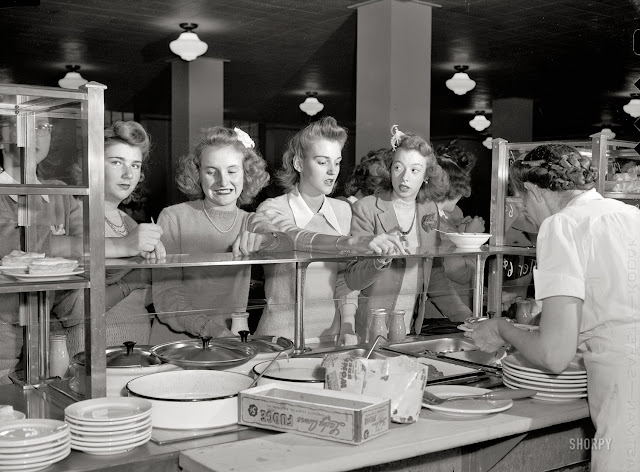 |
| October 1943. Washington, D.C. In the cafeteria at Woodrow Wilson High School. |
 |
| May 1943. Keysville, Virginia. Randolph Henry High School cafeteria. Typical lunch for 15 cents: candied yams, macaroni and cheese, fruit salad, deviled eggs, dessert and milk. Milk is free and children can have as much as they want. |
 |
| December 1943. Washington, D.C. In the canteen for enlisted men at the United Nations Service Center on a Saturday night. |
sippi (vicinity). Truck driver eating at a trucker’s stop along U.S. Highway 90. |
| March 1943. Pearlington, Missis |
| April 1943. Washington, D.C. Girl sitting alone in the Sea Grill waiting for a pickup. ‘I come in here pretty often, sometimes alone, mostly with another girl, we drink beer, and talk, and of course we keep our eyes open — you’d be surprised at how often nice lonesome soldiers ask Sue, the waitress, to introduce them to us.’ |
 |
| February 1940. Girls in beer parlor adjoining dance hall. Marshalltown, Iowa. |
 |
| October 1941. White Tower hamburger stand, the popular place in Amsterdam, New York. |
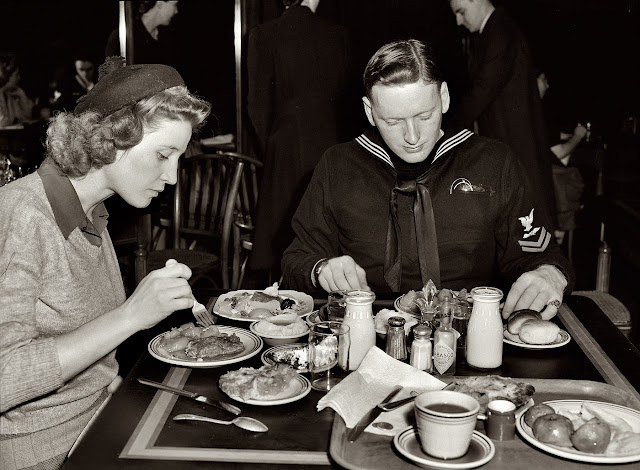 |
| December 1943. Washington, D.C. Hugh and Lynn Massman eating lunch at a cafeteria after a day of sightseeing. Their eight-week-old son is being taken care of at the United Nations service center nursery. |
 |
| “Cold drinks on the Fourth of July” at the Red Robin Coffee Shop in Vale, Oregon. The year was 1941. Can we stay just a little longer? |
To explore more fascinating stories and vintage news from the past, visit All Vintage News – your gateway to the enchanting world of vintage nostalgia.
(All images from Shorpy)

